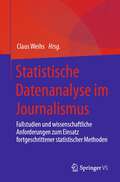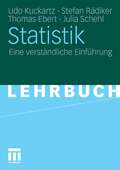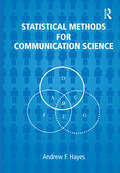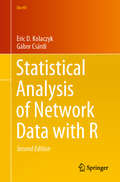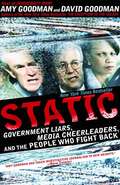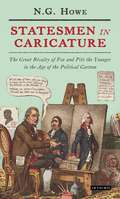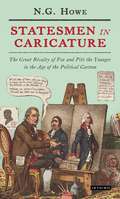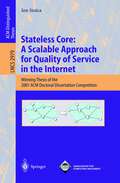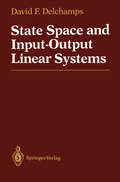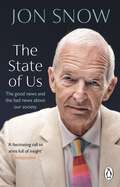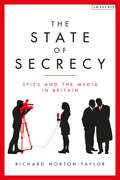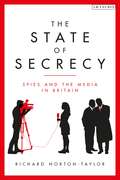- Table View
- List View
Statistische Informationstechnik: Signal - und Mustererkennung, Parameter- und Signalschätzung
by Kroschel Kristian Gerhard Rigoll Björn W. SchullerDie Autoren behandeln die Signalerkennung im Rauschen, die Mustererkennung sowie die Parameter- und Signalschätzung. Grundlegende Fragen veranschaulichen sie anhand von Anwendungsbeispielen. Berücksichtigt werden moderne Verfahren wie Wavelet-Transformation und neben klassischen Detektionsverfahren auch neuere, beispielsweise Klassifikatoren, die auf neuronale Netze und Fuzzy-Logik aufbauen. Die 5. Auflage wurde im Bereich des maschinellen Lernens substanziell erweitert. Der Band ist geeignet für Studierende wie für Ingenieure in der Praxis.
Statistische Datenanalyse im Journalismus: Fallstudien und wissenschaftliche Anforderungen zum Einsatz fortgeschrittener statistischer Methoden
Dieses Buch zeigt anhand von journalistischen Fallbeispielen, warum und wie fortgeschrittene statistische Analysemethoden eingesetzt werden können, um aussagekräftige journalistische Informationen aus Daten zu extrahieren. Gleichzeitig setzt das Buch einen Anforderungsrahmen für die datenjournalistische Arbeit bezüglich Datenkompetenz und -visualisierung, dem Einsatz von Algorithmen sowie daten-ethischen Anforderungen und der Überprüfung externer Studien. Ziel ist es, die Qualität und Aussagekraft datenjournalistischer Arbeiten zu verbessern, welche, neben der angemessenen Erfassung und Aufbereitung von Daten, wesentlich von einer adäquaten Datenanalyse abhängen. Aber wie statistisch arbeiten Datenjournalist:innen heute eigentlich? Und wie statistisch können oder sollten sie arbeiten, um den Ansprüchen ihrer Leserschaft in Sachen Verständlichkeit gerecht zu werden, auch mit Blick auf deren unterschiedliches mathematisch-statisches Vorwissen? Das Buch zielt darauf ab, diese Fragen zu beantworten, indem es weiterführende statistische Methoden anhand von Fallstudien untersucht. Es verdeutlicht, warum diese Methoden auch im journalistischen Kontext oftmals problemangemessener sind und tiefer gehende Erkenntnisse liefern als vereinfachte Analysen und Basismethoden. Die Fallstudien decken dabei die wichtigsten statistischen Methoden ab: Verteilungen und Tests, Klassifikation, Regression, Zeitreihenanalyse, Clusteranalyse, Analyse von sequentiellen Daten ohne direkten Zeitbezug, Verwendung von Vorwissen und geplante Studien.
Statistik: Eine verständliche Einführung
by Udo Kuckartz Stefan Rädiker Thomas Ebert Julia SchehlDieses Lehrbuch der statistischen Datenanalyse wurde speziell für Einführungskurse konzipiert und richtet sich an alle, die eine leicht verständliche Einführung in die sozialwissenschaftliche Statistik suchen. Es bezieht sich auf das Feld der Erziehungs- und Sozialwissenschaften und behandelt den Stoff nicht als inhaltsunabhängiges mathematisches Wissen. Sie lernen: • Die Basismethoden der Deskriptiv- und Inferenzstatistik • Die wichtigsten Techniken der graphischen Darstellung • Die Logik statistischen Argumentierens • Die Grundzüge komplexerer statistischer Verfahren • Outputs von SPSS bzw. SYSTAT richtig zu lesen • Resultate statistischer Analysen zu interpretieren • Ergebnisse von Forschungsprojekten zu verstehen
Statistical Robust Beamforming for Broadcast Channels and Applications in Satellite Communication (Foundations in Signal Processing, Communications and Networking #22)
by Andreas GründingerThis book investigates adaptive physical-layer beamforming and resource allocation that ensure reliable data transmission in the multi-antenna broadcast channel. The book provides an overview of robust optimization techniques and modelling approximations to deal with stochastic performance metrics. One key contribution of the book is a closed-form description of the achievable rates with unlimited transmit power for a rank-one channel error model. Additionally, the book provides a concise duality framework to transform mean square error (MSE) based beamformer designs, e.g., quality of service and balancing optimizations, into equivalent uplink filter designs. For the algorithmic solution, the book analyses the following paradigm: transmission to receivers with large MSE targets (low demands) is switched off if the transmit power is low. The book also studies chance constrained optimizations for limiting the outage probability. In this context, the book provides two novel conservative outage probability approximations, that result in convex beamformer optimizations. To compensate for the remaining inaccuracy, the book introduces a post-processing power allocation. Finally, the book applies the introduced beamformer designs for SatCom, where interference from neighboring spotbeams and channel fading are the main limitations.
Statistical Methods for Communication Science (Routledge Communication Series)
by Andrew F. HayesStatistical Methods for Communication Science is the only statistical methods volume currently available that focuses exclusively on statistics in communication research. Writing in a straightforward, personal style, author Andrew F. Hayes offers this accessible and thorough introduction to statistical methods, starting with the fundamentals of measurement and moving on to discuss such key topics as sampling procedures, probability, reliability, hypothesis testing, simple correlation and regression, and analyses of variance and covariance. Hayes takes readers through each topic with clear explanations and illustrations. He provides a multitude of examples, all set in the context of communication research, thus engaging readers directly and helping them to see the relevance and importance of statistics to the field of communication.Highlights of this text include:*thorough and balanced coverage of topics;*integration of classical methods with modern "resampling" approaches to inference;*consideration of practical, "real world" issues;*numerous examples and applications, all drawn from communication research;*up-to-date information, with examples justifying use of various techniques; and*a CD with macros, data sets, figures, and additional materials.This unique book can be used as a stand-alone classroom text, a supplement to traditional research methods texts, or a useful reference manual. It will be invaluable to students, faculty, researchers, and practitioners in communication, and it will serve to advance the understanding and use of statistical methods throughout the discipline.
Statistical Methods for Communication Science (Routledge Communication Series)
by Andrew F. HayesStatistical Methods for Communication Science is the only statistical methods volume currently available that focuses exclusively on statistics in communication research. Writing in a straightforward, personal style, author Andrew F. Hayes offers this accessible and thorough introduction to statistical methods, starting with the fundamentals of measurement and moving on to discuss such key topics as sampling procedures, probability, reliability, hypothesis testing, simple correlation and regression, and analyses of variance and covariance. Hayes takes readers through each topic with clear explanations and illustrations. He provides a multitude of examples, all set in the context of communication research, thus engaging readers directly and helping them to see the relevance and importance of statistics to the field of communication.Highlights of this text include:*thorough and balanced coverage of topics;*integration of classical methods with modern "resampling" approaches to inference;*consideration of practical, "real world" issues;*numerous examples and applications, all drawn from communication research;*up-to-date information, with examples justifying use of various techniques; and*a CD with macros, data sets, figures, and additional materials.This unique book can be used as a stand-alone classroom text, a supplement to traditional research methods texts, or a useful reference manual. It will be invaluable to students, faculty, researchers, and practitioners in communication, and it will serve to advance the understanding and use of statistical methods throughout the discipline.
Statistical Deception at Work
by John MauroWritten to reveal statistical deceptions often thrust upon unsuspecting journalists, this book views the use of numbers from a public perspective. Illustrating how the statistical naivete of journalists often nourishes quantitative misinformation, the author's intent is to make journalists more critical appraisers of numerical data so that in reporting them they do not deceive the public. The book frequently uses actual reported examples of misused statistical data reported by mass media and describes how journalists can avoid being taken in by them. Because reports of survey findings seldom give sufficient detail of methods on the actual questions asked, this book elaborates on questions reporters should ask about methodology and how to detect biased questions before reporting the findings to the public. As such, it may be looked upon as an "elements of style" for reporting statistics.
Statistical Deception at Work
by John MauroWritten to reveal statistical deceptions often thrust upon unsuspecting journalists, this book views the use of numbers from a public perspective. Illustrating how the statistical naivete of journalists often nourishes quantitative misinformation, the author's intent is to make journalists more critical appraisers of numerical data so that in reporting them they do not deceive the public. The book frequently uses actual reported examples of misused statistical data reported by mass media and describes how journalists can avoid being taken in by them. Because reports of survey findings seldom give sufficient detail of methods on the actual questions asked, this book elaborates on questions reporters should ask about methodology and how to detect biased questions before reporting the findings to the public. As such, it may be looked upon as an "elements of style" for reporting statistics.
Statistical Analysis of Network Data with R (Use R! #65)
by Eric D. Kolaczyk Gábor CsárdiThe new edition of this book provides an easily accessible introduction to the statistical analysis of network data using R. It has been fully revised and can be used as a stand-alone resource in which multiple R packages are used to illustrate how to conduct a wide range of network analyses, from basic manipulation and visualization, to summary and characterization, to modeling of network data. The central package is igraph, which provides extensive capabilities for studying network graphs in R. The new edition of this book includes an overhaul to recent changes in igraph. The material in this book is organized to flow from descriptive statistical methods to topics centered on modeling and inference with networks, with the latter separated into two sub-areas, corresponding first to the modeling and inference of networks themselves, and then, to processes on networks. The book begins by covering tools for the manipulation of network data. Next, it addresses visualization and characterization of networks. The book then examines mathematical and statistical network modeling. This is followed by a special case of network modeling wherein the network topology must be inferred. Network processes, both static and dynamic are addressed in the subsequent chapters. The book concludes by featuring chapters on network flows, dynamic networks, and networked experiments. Statistical Analysis of Network Data with R, 2nd Ed. has been written at a level aimed at graduate students and researchers in quantitative disciplines engaged in the statistical analysis of network data, although advanced undergraduates already comfortable with R should find the book fairly accessible as well.
Statistical Analyses for Language Testers
by R. GreenProvides a step-by-step approach to the most useful statistical analyses for language test developers and researchers using IBM SPSS, Winsteps and Facets. It contains clearly-worked out examples for each analysis with detailed explanations.
Static: Government Liars, Media Cheerleaders, and the People Who Fight Back
by Amy GoodmanTorture. Kidnapping. Bogus wars. Illegal wiretapping. Propaganda. Spies in the newsrooms. Oil profiteers. Soldiers who won't fight. Mothers of fallen soldiers Who will.In Static, the bestselling brother-sister team of Amy Goodman, host of Democracy Now!, and investigative journalist David Goodman takes on government liars, corporate profiteers, and the media that have acted as their cheerleaders. The authors cut through the official static to show the truth about war, torture, and government control of the media. Static breaks the sound barrier to present the voices of dissidents, activists, and others who are often frozen out of official debate.Read Static. Become informed. Fight back. Defend democracy.
Statesmen in Caricature: The Great Rivalry of Fox and Pitt the Younger in the Age of the Political Cartoon (International Library of Political Studies)
by N. G. HoweThe years 1780 to 1820 have long been seen as the Golden Age of the English satirical print. This period witnessed a number of changes in style which had far-reaching consequences, including an increase in the effectiveness of the caricature as visual propaganda. William Pitt the Younger and Charles James Fox were the leading politicians of the age, continuing a family rivalry begun by their fathers. They were amongst the most caricatured men of their time and became emblems of the two sides of the political debate whilst gathering personal followings, based upon personality rather than filial or political patronage. Fox and Pitt the Younger came to represent a more modern notion of the party leader, in an age before formalized political parties and structures. Neil Howe here shows how `stock images' came to the fore and examines the central role they played within the visual representation of politicians during the late-eighteenth century. His book also chronicles how the biggest political rivalry of the age played out within contemporary caricature, from the emergence of Fox and Pitt as big political beasts in the wake of the American Revolution, though the East India Bill Crisis; Regency Crisis and French Revolution to the death of both men in 1806.
Statesmen in Caricature: The Great Rivalry of Fox and Pitt the Younger in the Age of the Political Cartoon (International Library of Political Studies)
by N. G. HoweThe years 1780 to 1820 have long been seen as the Golden Age of the English satirical print. This period witnessed a number of changes in style which had far-reaching consequences, including an increase in the effectiveness of the caricature as visual propaganda. William Pitt the Younger and Charles James Fox were the leading politicians of the age, continuing a family rivalry begun by their fathers. They were amongst the most caricatured men of their time and became emblems of the two sides of the political debate whilst gathering personal followings, based upon personality rather than filial or political patronage. Fox and Pitt the Younger came to represent a more modern notion of the party leader, in an age before formalized political parties and structures. Neil Howe here shows how `stock images' came to the fore and examines the central role they played within the visual representation of politicians during the late-eighteenth century. His book also chronicles how the biggest political rivalry of the age played out within contemporary caricature, from the emergence of Fox and Pitt as big political beasts in the wake of the American Revolution, though the East India Bill Crisis; Regency Crisis and French Revolution to the death of both men in 1806.
Statesmanship: The Best of the New Statesman, 1913-2019
by VariousNo British periodical or weekly magazine has a richer and more distinguished archive than the New Statesman, which has long been at the centre of British political and cultural life. If not quite at the centre, then at the most energetic, subversive end of the progressive centre-left. Kingsley Martin, editor of the New Statesman from 1930 to 1960, wrote that "life on the NS was always a battle. After all, I had been brought up as a dissenter and I tended to see all problems as moral issues."The magazine has notably recognized and published new writers and critics, as well as encouraged major careers. Many of the most notable political and cultural writers of the recent past have written for the New Statesman. Many have been on its staff or were associates of it: HG Wells, George Bernard Shaw, JM Keynes, VS Pritchett, Paul Johnson, Claire Tomalin, Christopher Hitchens and John Gray. The most significant intellectual and cultural currents of the age ripple through its pages. There is, too, a rich history of poetry and fiction and illustration and cartoons to draw on, from Low's sketches of the great and the good to the gonzo art of Ralph Steadman and the bold cover illustrations and caricatures of André Carrilho.The book is more than an anthology. It tells the story of the New Statesman, from the eve of the First World War to the long aftermath of 9/11 and the populist upheavals of today. It looks forward as well as back, offering a unique and unpredictable perspective on politics, literature and the world.
Stateless Core: Winning Thesis of the 2001 ACM Doctoral Dissertation Competition (Lecture Notes in Computer Science #2979)
by Ion StoicaStatebuilding Missions and Media Development: A Context-Sensitive Approach (Routledge Studies in Intervention and Statebuilding)
by Kerstin TomiakThis book examines the effects of media interventions in the global South, and argues for a more adaptive and context-sensitive media development. The work investigates media development as part of statebuilding and the effects that Western-led media has in, and on, a newly built state. Drawing on extensive fieldwork, including interviews, observations and social surveys, it analyses the effect media interventions has on global South countries, from the population’s point of view. The findings show that in practice media development can be alien to the societies in which a free press is implemented, which can lead to unintended and negative consequences for social relations in a country. While the book uses South Sudan as a case study, it also presents different perspectives and shows that local views on the media are different from those of Western experts and policymakers. Therefore, the book advocates taking local views seriously and an adaptive media development that is sensitive to the context in which it is set up. This book will be of much interest to students of statebuilding, media studies, development studies and international relations in general.
Statebuilding Missions and Media Development: A Context-Sensitive Approach (Routledge Studies in Intervention and Statebuilding)
by Kerstin TomiakThis book examines the effects of media interventions in the global South, and argues for a more adaptive and context-sensitive media development. The work investigates media development as part of statebuilding and the effects that Western-led media has in, and on, a newly built state. Drawing on extensive fieldwork, including interviews, observations and social surveys, it analyses the effect media interventions has on global South countries, from the population’s point of view. The findings show that in practice media development can be alien to the societies in which a free press is implemented, which can lead to unintended and negative consequences for social relations in a country. While the book uses South Sudan as a case study, it also presents different perspectives and shows that local views on the media are different from those of Western experts and policymakers. Therefore, the book advocates taking local views seriously and an adaptive media development that is sensitive to the context in which it is set up. This book will be of much interest to students of statebuilding, media studies, development studies and international relations in general.
State Space and Input-Output Linear Systems
by David F. DelchampsIt is difficult for me to forget the mild sense of betrayal I felt some ten years ago when I discovered, with considerable dismay, that my two favorite books on linear system theory - Desoer's Notes for a Second Course on Linear Systems and Brockett's Finite Dimensional Linear Systems - were both out of print. Since that time, of course, linear system theory has undergone a transformation of the sort which always attends the maturation of a theory whose range of applicability is expanding in a fashion governed by technological developments and by the rate at which such advances become a part of engineering practice. The growth of the field has inspired the publication of some excellent books; the encyclopedic treatises by Kailath and Chen, in particular, come immediately to mind. Nonetheless, I was inspired to write this book primarily by my practical needs as a teacher and researcher in the field. For the past five years, I have taught a one semester first year gradu ate level linear system theory course in the School of Electrical Engineering at Cornell. The members of the class have always come from a variety of departments and backgrounds, and con sequently have entered the class with levels of preparation ranging from first year calculus and a taste of transform theory on the one extreme to senior level real analysis and abstract algebra on the other.
A State of War Exists: Reporters in the Line of Fire
by Michael Nicholson"The worst moment in a war was my fear I would not be sent to it." So wrote the young Michael Nicholson, a reporter whose astonishing career has covered eighteen major conflicts. Published to coincide with the thirtieth anniversary of the Falklands War, A State of War Exists sees the veteran journalist pondering what made him want to risk life and limb travelling to the most dangerous parts of the world, at the most dangerous times - over 200 journalists have been killed in the last three years alone. Was it machismo or masochism that encouraged him so compulsively and repeatedly to risk his life? Nicholson introduces us to trailblazers who have inspired him and countless others with their bravery, wisdom and skill in presenting the 'pity of war'.
The State of Us: The good news and the bad news about our society
by Jon Snow'A fascinating call to arms full of insight' IndependentAfter four decades broadcasting to the nation each night, Jon Snow gives vent to his opinions on the state of our nation . . . the good news and the bad newsIt is rare in history that so many nations in the developed world are in crisis at the same time. There has been a disintegration of trust in political leaders and in the media that holds them to account. For all the progress humankind has made, for all the inventions and new technologies, our society is being undermined by inequality. To fix it, we must begin by seeking out the truth about our world.In The State of Us, Jon Snow traces how the life of the nation has changed across his five-decade career, from getting thrown out of university for protesting apartheid to interviewing every prime minister since Margaret Thatcher.In doing so, he shows how the greatest problems at home and abroad so often come down to inequality and an unwillingness to confront it. But that is not our fate. Despite the challenges, Snow has witnessed profound social progress. In this passionate rallying cry, he argues that at its best, journalism reflects not just who we are now, but who we can be.We've had enough of division; the future is for us.
State-of-the-Art of Millimeter-Wave Silicon Technology (Lecture Notes in Electrical Engineering #945)
by Jaco du Preez Saurabh SinhaThis book examines the critical differences between current and next-generation Si technologies (CMOS, BiCMOS and SiC) and technology platforms (e.g. system-on-chip) in mm-wave wireless applications. We provide a basic overview of the two technologies from a technical standpoint, followed by a review of the state-of-the-art of several key building blocks in wireless systems. The influences of system requirements on the choice of semiconductor technology are vital to understanding the merits of CMOS and BiCMOS devices – e.g., output power, battery life, adjacent channel interference, cost restrictions, and so forth. These requirements, in turn, affect component-level design and performance metrics of oscillators, mixers, power and low-noise amplifiers, as well as phase-locked loops and data converters. Finally, the book offers a peek into the next generation of wireless technologies such as THz -band systems and future 6G applications.
The State of Secrecy: Spies and the Media in Britain
by Richard Norton-TaylorRichard Norton-Taylor reveals the secrets of his forty-year career as a journalist covering the world of spies and their masters in Whitehall. Early in his career, Norton-Taylor successfully campaigned against official secrecy, gaining a reputation inside the Whitehall establishment and the outside world alike for his relentless determination to expose wrongdoing and incompetence. His special targets have always been the security and intelligence agencies and the Ministry of Defence, institutions that often hide behind the cloak of national security to protect themselves from embarrassment and being held to account. Encouraged by his trusted contacts in intelligence agencies and Whitehall departments, Norton-Taylor was among the first of the few journalists consistently to attack the planned invasion of Iraq in 2003 and subsequently covered for the Guardian the devastating evidence of every witness to the Chilcot inquiry. He also enjoyed unique access to a wide array of defence sources, giving him a rare insight into the disputes among top military commanders as they struggled to fight wars in Iraq and Afghanistan with under-resourced and ill-equipped troops.Described by a former senior Intelligence official as a 'long-term thorn in the side of the intelligence establishment', and winner of numerous awards for his journalism, Norton-Taylor is one of the most respected defence and security journalists of his generation. Provocative, and rich in anecdotes, The State of Secrecy is an illuminating, critical and, at times, provocative account of the author's experiences investigating the secret world.
The State of Secrecy: Spies and the Media in Britain
by Richard Norton-TaylorRichard Norton-Taylor reveals the secrets of his forty-year career as a journalist covering the world of spies and their masters in Whitehall. Early in his career, Norton-Taylor successfully campaigned against official secrecy, gaining a reputation inside the Whitehall establishment and the outside world alike for his relentless determination to expose wrongdoing and incompetence. His special targets have always been the security and intelligence agencies and the Ministry of Defence, institutions that often hide behind the cloak of national security to protect themselves from embarrassment and being held to account. Encouraged by his trusted contacts in intelligence agencies and Whitehall departments, Norton-Taylor was among the first of the few journalists consistently to attack the planned invasion of Iraq in 2003 and subsequently covered for the Guardian the devastating evidence of every witness to the Chilcot inquiry. He also enjoyed unique access to a wide array of defence sources, giving him a rare insight into the disputes among top military commanders as they struggled to fight wars in Iraq and Afghanistan with under-resourced and ill-equipped troops.Described by a former senior Intelligence official as a 'long-term thorn in the side of the intelligence establishment', and winner of numerous awards for his journalism, Norton-Taylor is one of the most respected defence and security journalists of his generation. Provocative, and rich in anecdotes, The State of Secrecy is an illuminating, critical and, at times, provocative account of the author's experiences investigating the secret world.
The State of Scholarly Publishing: Challenges and Opportunities
by Harold LaskiFor decades, university presses and other scholarly and professional publishers in the United States played a pivotal role in the transmission of scholarly knowledge. Their books and journals became the "gold standard" in many academic fields for tenure, promotion, and merit pay. Their basic business model was successful, since this diverse collection of presses had a unique value proposition. They dominated the scholarly publishing field with preeminent sales in three major markets or channels of distribution: libraries and institutions; college and graduate school adoptions; and general readers (i.e., sales to general retailers).Yet this insulated world changed abruptly in the late 1990s. What happened? This book contains a superb series of articles originally published in The Journal of Scholarly Publishing, by some of the best experts on scholarly communication in the western hemisphere, Europe, Asia, and Africa. These authors analyze in depth the diverse and exciting challenges and opportunities scholars, universities, and publishers face in what is a period of unusual turbulence in scholarly publishing.The topics given attention include: copyrights, the transformation of scholarly publishing from a print format to a digital one, open access, scholarly publishing in emerging nations, problems confronting journals, and information on how certain academic disciplines are coping with the transformation of scholarly publishing. This book is a must read for anyone interested in the scholarly publishing industry's past, its current focus, or future plans and developments.
The State of Scholarly Publishing: Challenges and Opportunities
by Harold LaskiFor decades, university presses and other scholarly and professional publishers in the United States played a pivotal role in the transmission of scholarly knowledge. Their books and journals became the "gold standard" in many academic fields for tenure, promotion, and merit pay. Their basic business model was successful, since this diverse collection of presses had a unique value proposition. They dominated the scholarly publishing field with preeminent sales in three major markets or channels of distribution: libraries and institutions; college and graduate school adoptions; and general readers (i.e., sales to general retailers).Yet this insulated world changed abruptly in the late 1990s. What happened? This book contains a superb series of articles originally published in The Journal of Scholarly Publishing, by some of the best experts on scholarly communication in the western hemisphere, Europe, Asia, and Africa. These authors analyze in depth the diverse and exciting challenges and opportunities scholars, universities, and publishers face in what is a period of unusual turbulence in scholarly publishing.The topics given attention include: copyrights, the transformation of scholarly publishing from a print format to a digital one, open access, scholarly publishing in emerging nations, problems confronting journals, and information on how certain academic disciplines are coping with the transformation of scholarly publishing. This book is a must read for anyone interested in the scholarly publishing industry's past, its current focus, or future plans and developments.

